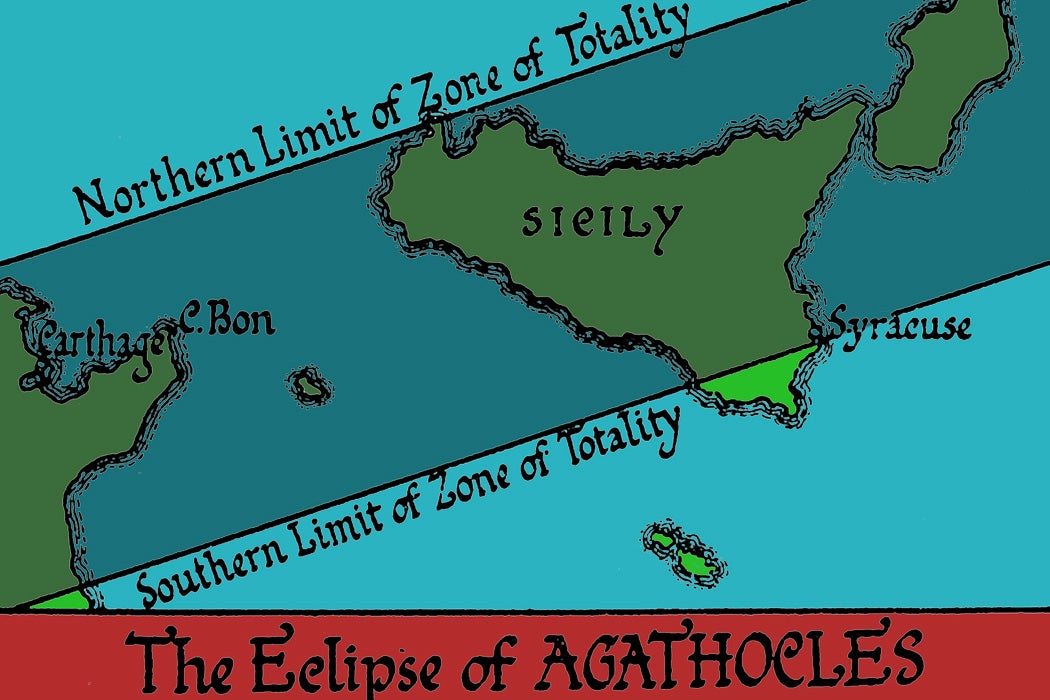Among the many stories of the ancient world described by the ancient Greek historian Herodotus was a battle in Western Asia between the Medes and the Lydians. The fight was notable mainly for the fact that it was interrupted when “day was on a sudden changed into night,” after which the warning parties quickly agreed to make peace. Herodotus also claimed that the event had previously been predicted by the philosopher Thales of Miletus.
As science historian Matthew Stanley writes, two millennia later, the story caught the interest of astronomers, who sought to use their knowledge of celestial mechanics to determine just when this apparent solar eclipse occurred. Between the sixteenth and nineteenth centuries, scientists including Isaac Newton took up the question but failed to reach a consensus. Estimates ranged from 626 to 583 BCE.
In 1811, Stanley writes, British astronomer Francis Baily tried again, using newly developed tables for calculating the Moon’s motion. He confidently wrote that the battle had actually taken place on September 30, 610 BCE. Yet when Baily tried to date other eclipses mentioned in ancient Greek writings, he was less successful—often failing to find a time and place that even generally fit the historical accounts. Reluctantly, he suggested that it might be necessary to make “some alteration” in astronomers’ calculations of lunar movement.
In the 1850s, another British astronomer, George Airy, took the problem from the opposite direction, attempting to use historical clues to determine a factor in the Moon’s movements over the centuries known as secular acceleration. He focused his attention on a historical account of an eclipse seen by Agathocles, the tyrant of Syracuse, as he fled a blockade by Carthaginian forces. Airy, who had a background in classical studies himself, worked with historians and naval experts to try to figure out which route would have made most sense to the ancient figure and how quickly he could have sailed along various paths.
Stanley writes that Airy’s methods, using historical accounts to guide astronomic theories, were widely accepted by other astronomers for a time. But in 1878, it was challenged by American astronomer Simon Newcomb. Newcomb was far more skeptical about claims regarding historical accounts of eclipses. For example, he suggested that Herodotus’s battle story may have actually described a partial eclipse, a dark cloud covering the Sun, or even just nightfall appearing to come “on a sudden” as the armies were swept up in fighting.
Weekly Newsletter
Newcomb was devoted to promoting a standard of scientific thinking that depended on careful training. Unlike classically trained scholars like Airy, who viewed ancient Greek scholars as something like peers, he distrusted the reports of people who had no concept of modern science.
Ultimately, it was scientific progress that solved the secular acceleration question. Reflectors placed on the Moon by Apollo astronauts allowed researchers to measure it directly. Today, astronomers are confident that a solar eclipse was visible in Western Asia in 585 BCE, but historians remain unsure about whether it really interrupted a battle.
Teaching Tips
Incorporate primary resources:
Many of the published writings of Francis Baily, George Airy, and Simon Newcomb are available open access via JSTOR and elsewhere. A few examples:
- Francis Baily, “On the Solar Eclipse Which Is Said to Have Been Predicted by Thales,” Philosophical Transactions of the Royal Society of London 101 (1811): 220–41.
- George Biddell Airy, “On the Eclipses of Agathocles, Thales, and Xerxes,” Philosophical Transactions of the Royal Society of London 143 (1853): 179–200.
- George Biddell Airy, “On the Results of Recent Calculations on the Eclipse of Thales and Eclipses Connected With It,” Notices of the Proceedings at the Meetings of the Members of the Royal Institution of Great Britain 1 (1854): 243–250.
- Simon Newcomb, “On the Secular Variations and Mutual Relations of the Orbits of the Asteroids,” Memoirs of the American Academy of Arts and Sciences 8, no. 1 (1861): 123–52.
- Simon Newcomb, Researches on the Motion of the Moon (Washington, DC: Government Printing Office, 1878).
Support JSTOR Daily! Join our membership program on Patreon today.







